With new farm quads now in the region of €9,000 to €12,000 plus VAT depending on brand and spec, interest in secondhand machines is increasing.
As is the case when buying any second-hand machine, it is important to know what to look out for in a machine.
Remember, the day you buy is the day you sell and a used quad from a recognised brand with a proven track record is a better buy than a new quad from a knock-off brand. Although such machines initially appear to be good value, one should proceed with caution as reliability and availability of spare parts may be an issue. 
Ensure the vehicle identification number is present and has not been tampered with.
1 General appearance
General appearance will tell you a lot about a machine’s history. Aside from cosmetics, it’s important to inspect the quad structurally. Plastic panels are generally cheaper to replace and an easier fix compared to a cracked or strained chassis. Strain can occur if a machine has been used for towing heavier loads than it is rated for or pulling from the wrong location, such as cargo racks. If there are obvious signs of strain, cracks or that the quad has been previously damaged, we would advise passing.
That said, the plastic panels should be intact and in good shape. If damaged, factor replacement into the buying price. Tyre condition should also be another factor taken into consideration. New tyres will set you back from €75-€110 each including VAT depending on brand and size. 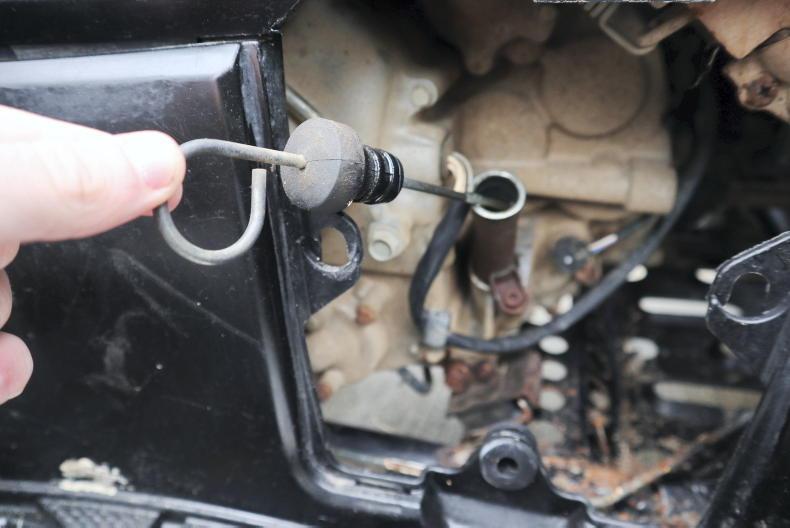
Firstly, check the oil level and air filter condition before starting the engine.
2 Engine
There will always be greater peace of mind when buying from a reputable dealer, with many servicing machines and some offering a warranty.
This isn’t always the case, especially when buying private, so it is advised to view the quad while its engine is cold. Check the oil level and air filter condition before starting the engine. Once started, listen to how the engine idles and whether it is smokey or not. It should start easily and idle smoothly. A little white smoke on start-up can be normal with a machine that hasn’t been started in some time once it disappears within 30 or so seconds. This is water vapour burning off.
A petrol engine that is hard or lazy starting generally has one of two issues. Either there is a worn spark plug or the starter motor is in need of repair. A machine that is misfiring or remains smokey once warmed should be questioned and potentially avoided. The sound of an engine and how it responds while driving is a good indication as to its health. 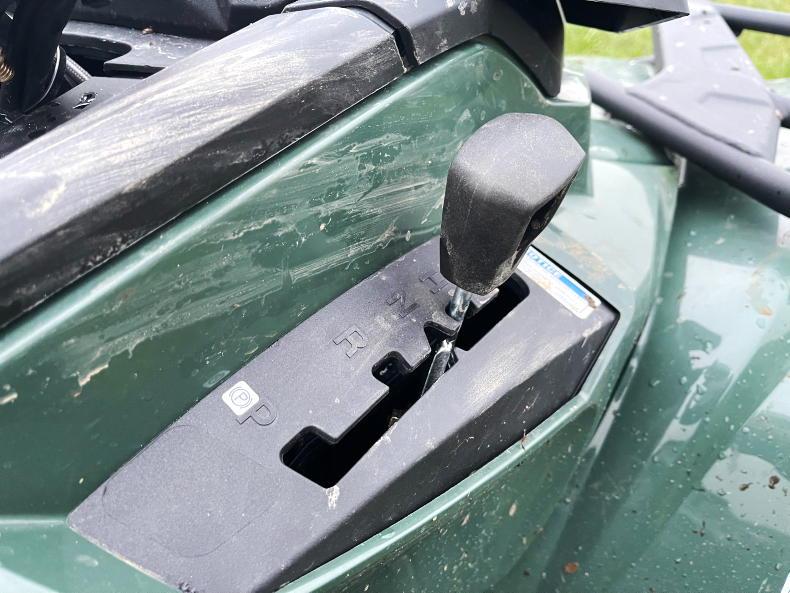
When checking the transmission, ensure each gear change is smooth and easily selected on both the upshift and downshift.
3 Transmission
Although the trend on the new market is towards belt-driven CVT-type transmissions, many of the older quads on the used market are fitted with manual pedal shift or electric shift transmissions. Manual shift tends to be trouble-free while electric shift, depending on how the machine was operated by its previous owner (starting off in high gears, labouring etc), can slip or fail to select gears due to worn brushes in the electric shift motor. Ensure each gear change is smooth and easily selected on both the upshift and downshift.
Although belt-drive CVTs may sound complicated, they are quite the opposite. These are generally maintenance-free once not continually abused under load. Belt slippage while driving generally indicates that the belt itself needs to be replaced, which is a relatively inexpensive fix.
Machines with selectable 4WD should be checked, ensuring it engages and disengages at the press of the button. It’s not uncommon for the 4WD to not disengage straight away; coming to a stop or engaging the brakes generally does the trick. A non-functioning 4WD can have several possible causes and a potentially costly repair up to €600 including VAT. If fitted, the front and rear locking differentials should be checked to see if they’re engaging and disengaging. If it’s a dealer’s machine, we advise having any issues rectified in the sale agreement. 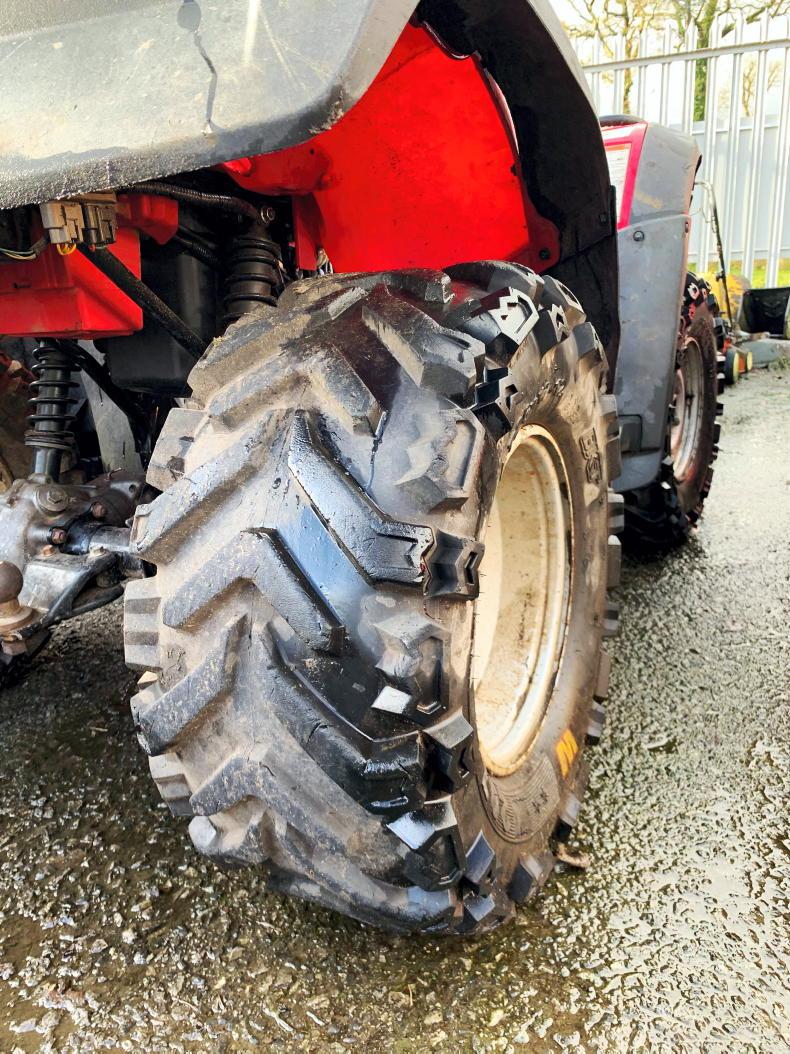
New tyres will set you back from €75-€110 each including VAT depending on brand and size.
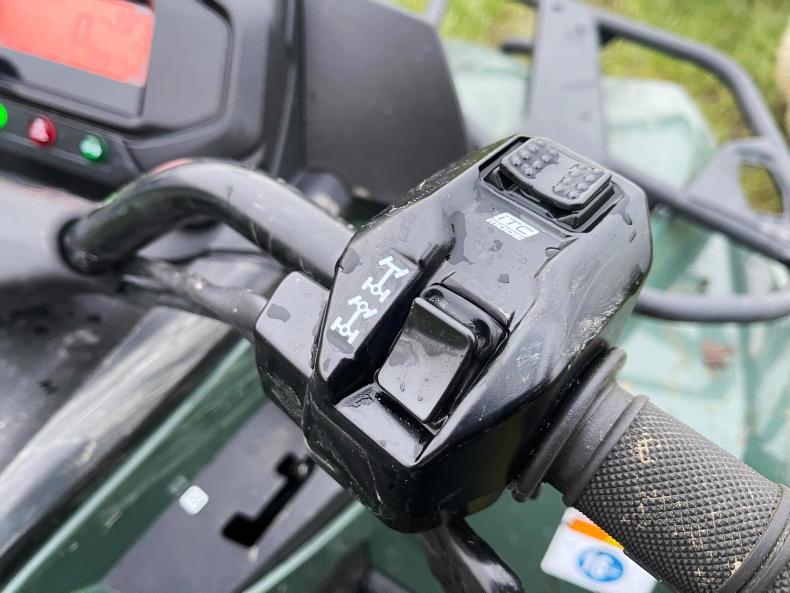
Machines with selectable 4WD should be checked ensuring it engages and disengages at the press of the button.
4 Steering, suspension and brakes
It’s important to check the handlebars for play in the steering. They should not move without a response from the wheels. A little play (5mm) is acceptable, but excessive play would indicate possible wear in ball joints, track rod ends or wheel bearings. Wheel bearings can be checked by rocking each wheel. A worn wheel bearing gone unnoticed can result in hub damage, leading to costly replacement. Clicking or cracking sounds on the go will indicate worn CV joints.
Check the machine’s suspension. Machines with independent suspension will have a lot more moving parts. Check bearing condition in each swingarm and that linkages and pivots are not damaged. Check that the suspension returns to its normal position once compressed. Replacement shocks can cost in the region of €150 including VAT.
The condition of brakes should be examined. Disc brakes should have both pad and disc condition examined for wear and proper functionality. Many machines with foot brakes and or drum brakes are prone to seizing. With foot brakes in particular, the brake cable generally ceases from lack of use or built-up dirt and results in brakes sticking on. It’s vital brakes are working correctly. 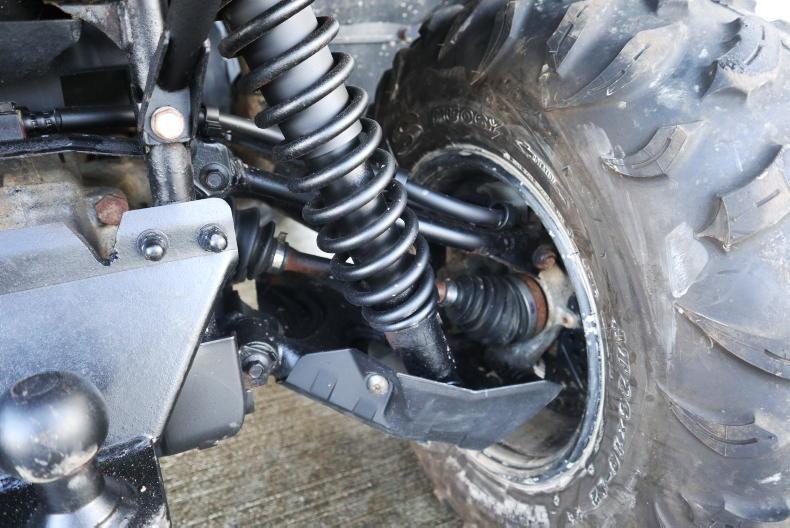
Check bearing condition in each swingarm and that linkages and pivots are not damaged.
5 Machine history
In recent years, the financing of new and used ATVs has become quite popular. If buying such a used machine, it’s advisable to carry out a finance check to ensure there is no remaining debt. One of the biggest things to check when buying a used quad is to ensure it hasn’t been stolen. Ensure the Vehicle Identification Number (VIN), more commonly known as the chassis number, is present and has not been tampered with.
And finally, if you have bit the bullet and invested in an ATV, we would strongly advise investing in a tracking device. Such units are relatively inexpensive, are easily fitted and record the machine’s location at any given point in time, helping with relocation if a theft ever occurs.
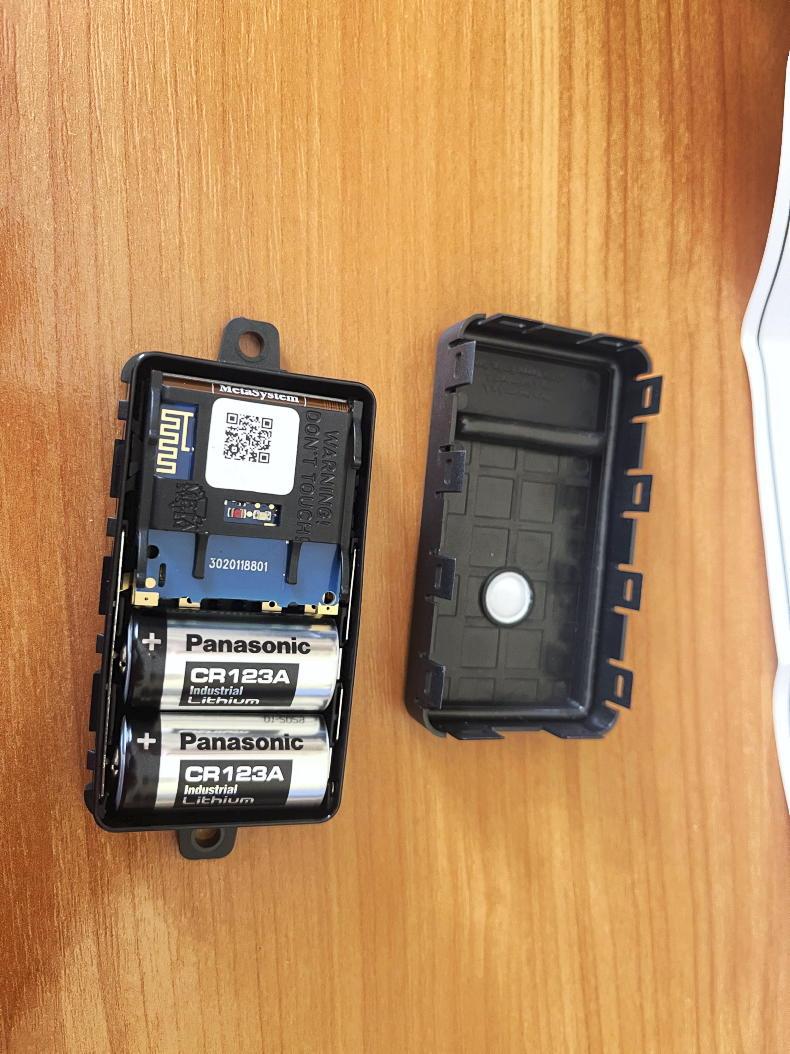
If you have invested in an ATV, we would strongly advise to consider investing in a tracking device which are inexpensive are easily fitted.
With new farm quads now in the region of €9,000 to €12,000 plus VAT depending on brand and spec, interest in secondhand machines is increasing.
As is the case when buying any second-hand machine, it is important to know what to look out for in a machine.
Remember, the day you buy is the day you sell and a used quad from a recognised brand with a proven track record is a better buy than a new quad from a knock-off brand. Although such machines initially appear to be good value, one should proceed with caution as reliability and availability of spare parts may be an issue. 
Ensure the vehicle identification number is present and has not been tampered with.
1 General appearance
General appearance will tell you a lot about a machine’s history. Aside from cosmetics, it’s important to inspect the quad structurally. Plastic panels are generally cheaper to replace and an easier fix compared to a cracked or strained chassis. Strain can occur if a machine has been used for towing heavier loads than it is rated for or pulling from the wrong location, such as cargo racks. If there are obvious signs of strain, cracks or that the quad has been previously damaged, we would advise passing.
That said, the plastic panels should be intact and in good shape. If damaged, factor replacement into the buying price. Tyre condition should also be another factor taken into consideration. New tyres will set you back from €75-€110 each including VAT depending on brand and size. 
Firstly, check the oil level and air filter condition before starting the engine.
2 Engine
There will always be greater peace of mind when buying from a reputable dealer, with many servicing machines and some offering a warranty.
This isn’t always the case, especially when buying private, so it is advised to view the quad while its engine is cold. Check the oil level and air filter condition before starting the engine. Once started, listen to how the engine idles and whether it is smokey or not. It should start easily and idle smoothly. A little white smoke on start-up can be normal with a machine that hasn’t been started in some time once it disappears within 30 or so seconds. This is water vapour burning off.
A petrol engine that is hard or lazy starting generally has one of two issues. Either there is a worn spark plug or the starter motor is in need of repair. A machine that is misfiring or remains smokey once warmed should be questioned and potentially avoided. The sound of an engine and how it responds while driving is a good indication as to its health. 
When checking the transmission, ensure each gear change is smooth and easily selected on both the upshift and downshift.
3 Transmission
Although the trend on the new market is towards belt-driven CVT-type transmissions, many of the older quads on the used market are fitted with manual pedal shift or electric shift transmissions. Manual shift tends to be trouble-free while electric shift, depending on how the machine was operated by its previous owner (starting off in high gears, labouring etc), can slip or fail to select gears due to worn brushes in the electric shift motor. Ensure each gear change is smooth and easily selected on both the upshift and downshift.
Although belt-drive CVTs may sound complicated, they are quite the opposite. These are generally maintenance-free once not continually abused under load. Belt slippage while driving generally indicates that the belt itself needs to be replaced, which is a relatively inexpensive fix.
Machines with selectable 4WD should be checked, ensuring it engages and disengages at the press of the button. It’s not uncommon for the 4WD to not disengage straight away; coming to a stop or engaging the brakes generally does the trick. A non-functioning 4WD can have several possible causes and a potentially costly repair up to €600 including VAT. If fitted, the front and rear locking differentials should be checked to see if they’re engaging and disengaging. If it’s a dealer’s machine, we advise having any issues rectified in the sale agreement. 
New tyres will set you back from €75-€110 each including VAT depending on brand and size.

Machines with selectable 4WD should be checked ensuring it engages and disengages at the press of the button.
4 Steering, suspension and brakes
It’s important to check the handlebars for play in the steering. They should not move without a response from the wheels. A little play (5mm) is acceptable, but excessive play would indicate possible wear in ball joints, track rod ends or wheel bearings. Wheel bearings can be checked by rocking each wheel. A worn wheel bearing gone unnoticed can result in hub damage, leading to costly replacement. Clicking or cracking sounds on the go will indicate worn CV joints.
Check the machine’s suspension. Machines with independent suspension will have a lot more moving parts. Check bearing condition in each swingarm and that linkages and pivots are not damaged. Check that the suspension returns to its normal position once compressed. Replacement shocks can cost in the region of €150 including VAT.
The condition of brakes should be examined. Disc brakes should have both pad and disc condition examined for wear and proper functionality. Many machines with foot brakes and or drum brakes are prone to seizing. With foot brakes in particular, the brake cable generally ceases from lack of use or built-up dirt and results in brakes sticking on. It’s vital brakes are working correctly. 
Check bearing condition in each swingarm and that linkages and pivots are not damaged.
5 Machine history
In recent years, the financing of new and used ATVs has become quite popular. If buying such a used machine, it’s advisable to carry out a finance check to ensure there is no remaining debt. One of the biggest things to check when buying a used quad is to ensure it hasn’t been stolen. Ensure the Vehicle Identification Number (VIN), more commonly known as the chassis number, is present and has not been tampered with.
And finally, if you have bit the bullet and invested in an ATV, we would strongly advise investing in a tracking device. Such units are relatively inexpensive, are easily fitted and record the machine’s location at any given point in time, helping with relocation if a theft ever occurs.

If you have invested in an ATV, we would strongly advise to consider investing in a tracking device which are inexpensive are easily fitted.


















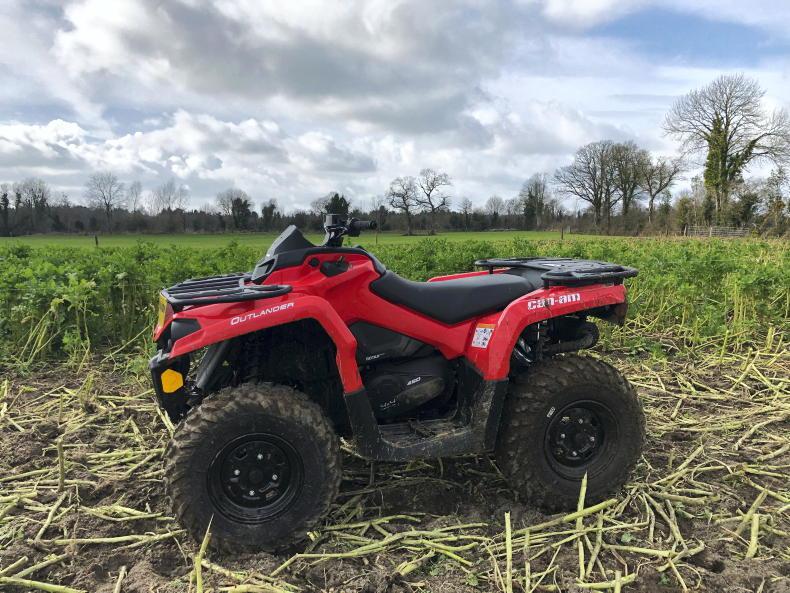
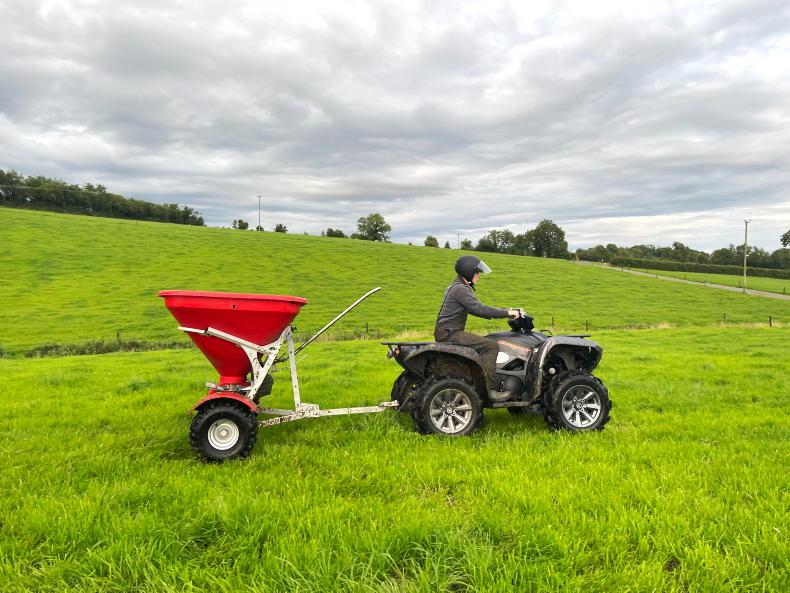
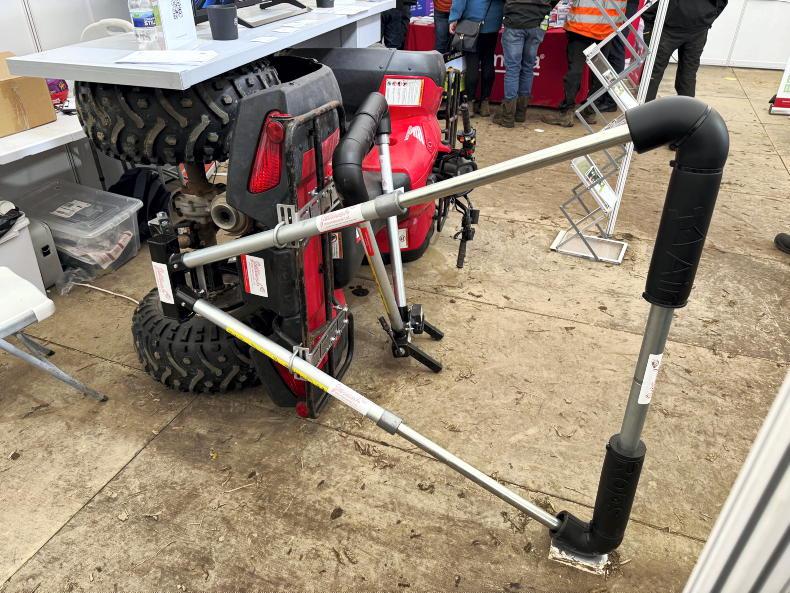


SHARING OPTIONS